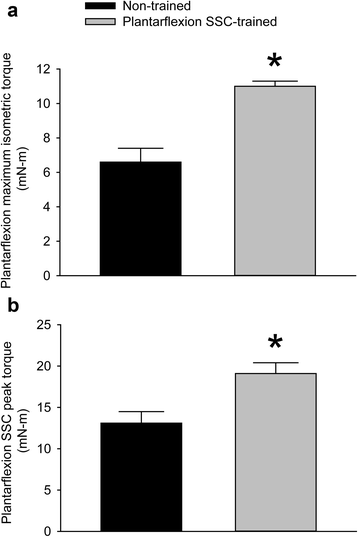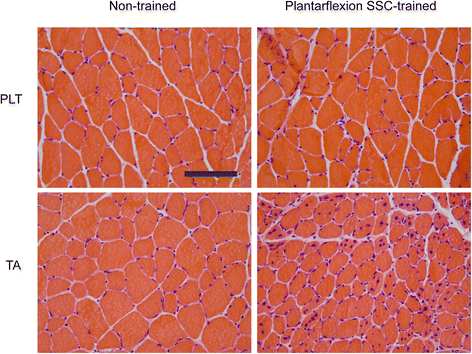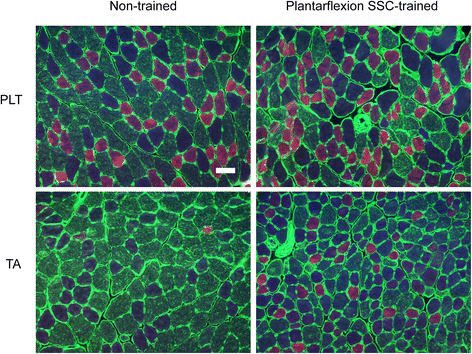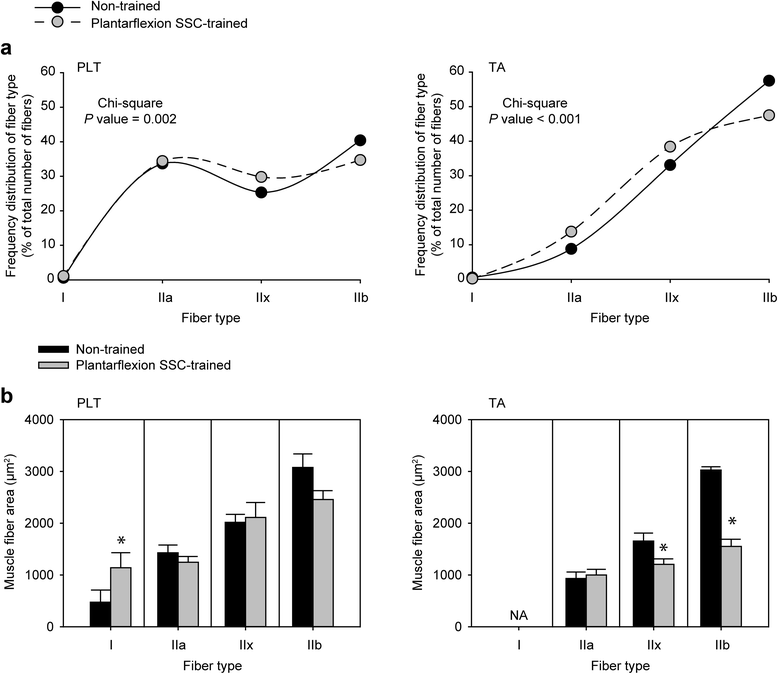Agonist muscle adaptation accompanied by antagonist muscle atrophy in the hindlimb of mice following stretch-shortening contraction training
- PMID: 28148306
- PMCID: PMC5288976
- DOI: 10.1186/s12891-017-1397-4
Agonist muscle adaptation accompanied by antagonist muscle atrophy in the hindlimb of mice following stretch-shortening contraction training
Abstract
Background: The vast majority of dynamometer-based animal models for investigation of the response to chronic muscle contraction exposure has been limited to analysis of isometric, lengthening, or shortening contractions in isolation. An exception to this has been the utilization of a rat model to study stretch-shortening contractions (SSCs), a sequence of consecutive isometric, lengthening, and shortening contractions common during daily activity and resistance-type exercise. However, the availability of diverse genetic strains of rats is limited. Therefore, the purpose of the present study was to develop a dynamometer-based SSC training protocol to induce increased muscle mass and performance in plantarflexor muscles of mice.
Methods: Young (3 months old) C57BL/6 mice were subjected to 1 month of plantarflexion SSC training. Hindlimb muscles were analyzed for muscle mass, quantitative morphology, myogenesis/myopathy relevant gene expression, and fiber type distribution.
Results: The main aim of the research was achieved when training induced a 2-fold increase in plantarflexion peak torque output and a 19% increase in muscle mass for the agonist plantaris (PLT) muscle. In establishing this model, several outcomes emerged which raised the value of the model past that of being a mere recapitulation of the rat model. An increase in the number of muscle fibers per transverse muscle section accounted for the PLT muscle mass gain while the antagonist tibialis anterior (TA) muscle atrophied by 30% with preferential atrophy of type IIb and IIx fibers. These alterations were accompanied by distinct gene expression profiles.
Conclusions: The findings confirm the development of a stretch-shortening contraction training model for the PLT muscle of mice and demonstrate that increased cross-sectional fiber number can occur following high-intensity SSC training. Furthermore, the TA muscle atrophy provides direct evidence for the concept of muscle imbalance in phasic non-weight bearing muscles, a concept largely characterized based on clinical observation of patients. The susceptibility to this imbalance is demonstrated to be selective for the type IIb and IIx muscle fiber types. Overall, the study highlights the importance of considering muscle fiber number modulation and the effect of training on surrounding muscles in exercise comprised of SSCs.
Keywords: Biomechanics; C57BL6 mice; Dorsiflexor muscles; Muscle fiber type; Muscle physiology; Myosin heavy chain; Plantarflexor muscles; Stretch-shortening contractions.
Figures






Similar articles
-
High-intensity stretch-shortening contraction training modifies responsivity of skeletal muscle in old male rats.Exp Gerontol. 2018 Apr;104:118-126. doi: 10.1016/j.exger.2018.02.009. Epub 2018 Feb 10. Exp Gerontol. 2018. PMID: 29438735
-
Muscle mechanics: adaptations with exercise-training.Exerc Sport Sci Rev. 1996;24:427-73. Exerc Sport Sci Rev. 1996. PMID: 8744258 Review.
-
Stretch-shortening cycle exercises: an effective training paradigm to enhance power output of human single muscle fibers.J Appl Physiol (1985). 2006 Mar;100(3):771-9. doi: 10.1152/japplphysiol.01027.2005. Epub 2005 Dec 1. J Appl Physiol (1985). 2006. PMID: 16322375 Clinical Trial.
-
Repeated stretch-shortening contraction of the triceps surae attenuates muscle atrophy and liver dysfunction in a rat model of inflammation.Exp Physiol. 2020 Jul;105(7):1111-1123. doi: 10.1113/EP088622. Epub 2020 Jun 8. Exp Physiol. 2020. PMID: 32394614
-
The determinants of skeletal muscle force and power: their adaptability with changes in activity pattern.J Biomech. 1991;24 Suppl 1:111-22. doi: 10.1016/0021-9290(91)90382-w. J Biomech. 1991. PMID: 1791172 Review.
Cited by
-
VCAM-1 upregulation accompanies muscle remodeling following resistance-type exercise in Snell dwarf (Pit1dw/dw ) mice.Aging Cell. 2018 Oct;17(5):e12816. doi: 10.1111/acel.12816. Epub 2018 Jul 10. Aging Cell. 2018. PMID: 29992743 Free PMC article.
-
Elevated muscle mass accompanied by transcriptional and nuclear alterations several months following cessation of resistance-type training in rats.Physiol Rep. 2022 Oct;10(20):e15476. doi: 10.14814/phy2.15476. Physiol Rep. 2022. PMID: 36259109 Free PMC article.
-
Bone Formation and Adaptive Morphology of the Anterior Tibial Muscle in 3-mm Daily Lengthening Using High-Fractional Automated Distraction and Osteosynthesis with the Ilizarov Apparatus Combined with Intramedullary Hydroxyapatite-Coated Wire.Biomed Res Int. 2019 Apr 21;2019:3241263. doi: 10.1155/2019/3241263. eCollection 2019. Biomed Res Int. 2019. PMID: 31119163 Free PMC article.
-
Preclinical assessment of rodent jumping power with a novel electrical stimulation-assisted device.Sci Rep. 2023 Oct 13;13(1):17371. doi: 10.1038/s41598-023-44748-6. Sci Rep. 2023. PMID: 37833409 Free PMC article.
-
Skeletal Muscle Quality: A Biomarker for Assessing Physical Performance Capabilities in Young Populations.Front Physiol. 2021 Aug 5;12:706699. doi: 10.3389/fphys.2021.706699. eCollection 2021. Front Physiol. 2021. PMID: 34421645 Free PMC article. Review.
References
-
- Trovato FM, Imbesi R, Conway N, Castrogiovanni P. Morphological and functional aspects of human skeletal muscle. J Funct Morphol Kinesiol. 2016;1(3):289–302. doi: 10.3390/jfmk1030289. - DOI
-
- Musumeci G, Imbesi R, Trovato FM, Szychlinska MA, Aiello FC, Buffa P, Castrogiovanni P. Importance of serotonin (5-HT) and its precursor l-tryptophan for homeostasis and function of skeletal muscle in rats. A morphological and endocrinological study. Acta Histochem. 2015;117(3):267–274. doi: 10.1016/j.acthis.2015.03.003. - DOI - PubMed
Publication types
MeSH terms
LinkOut - more resources
Full Text Sources
Other Literature Sources
Miscellaneous

